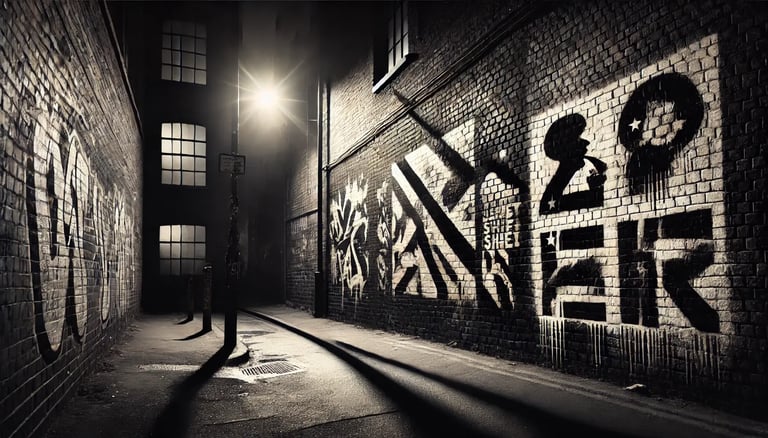Sell-out, stuntman, savant A quick peek inside Banksy’s brain

By Cape Capital
31.10.2024

He lurks street corners at night and makes appearances when you least expect it. You see traces of him, but never actually the man himself. He’s shrouded in mystery. And don’t you dare utter his name – even if you do know who he is.
We’re not talking about a ghost: we’re talking about Banksy, one of the most notorious artists of our time. Based in England and working anonymously, he’s best known for his kitschy street art made using a distinctive stencil technique, often drawing on political satire and tongue-in-cheek observations about societal events.
The making of a cultural icon
Since he started in the ’90s, Banksy has built a huge global appeal. His works pop up on your Instagram feed (at present, he boasts more than 13 million followers), on news briefings and, if you’re lucky, on street corners during your commute. Having reached a level of mainstream popularity which is almost uncontested in the contemporary art world, putting him on a footing with the likes of Andy Warhol and Keith Haring, some people praise him for his political grit; others see him as a PR stuntman or sell-out. His work has had an impact on heritage law applying to art on the streets, and, over the last two decades, it’s estimated that he’s raised almost £30 million for charity. A long-running Robin Hood figure, he’s a major player in the art market, yet a large portion of critics appear to detest him: The Guardian’s Jonathan Jones argued “Banksy’s work is not real art” after his 2002 'Girl with Balloon' work was voted Britain’s 'best-loved' artwork in 2017.
Fast forward to 2024 and the pseudonymous figure has been busy as usual – but being an internationally-renowned street artist doesn’t come without its hurdles. Earlier this year, tenants living in north London feared their rent would be hiked after he painted a mural of a Banksy tree on the side of their building. And, after former Home Secretary James Cleverly criticised his migrant boat artwork at Glastonbury Festival as “deeply distasteful”, he’s toeing a careful line.

Impact beyond the canvas: Banksy's influence on communities and law
Susan Hansen works at Middlesex University, where she’s co-chair of the Visual and Creative Methods Group. She also edits Nuart journal, is the president of the International Visual Sociological Association, and has been studying Banksy for more than a decade. “It’s a really fascinating subject for visual sociology,” Hansen says. Her interest can be traced back to 2012, when Banksy created a work named “Slave Labour” on the side of a Poundland store in Turnpike Lane: a mural of a child at a sewing machine making Union Jack bunting, arriving during a time of fervent nationalism during the Queen’s Diamond Jubilee and the London Olympics.
“Poundland was selling the bunting and there was a scandal with them getting involved in sweatshop labour that hired children,” Hansen says. The work became the subject of her research, photographing how the wall changed over time and exploring how the local community responded to the sudden presence of the Banksy. “If he hits a wall, things happen – the wall gets magnetised,” she says. ‘“Other artists, street artists and graffiti writers and ordinary people will make their own marks on that wall, or somebody might try to steal it. There’s an initial buzz of excitement, but also a longer tail of activity.”
Locals swiftly became attached to the work and were left disgruntled when it was removed from the wall at night and shipped off to Miami for a private auction, arranged by the people who rented the building to Poundland. “People were writing on the wall ‘bring back our Banksy’ and even the local MP was on the news, demanding it was returned,” Hansen says. The ephemerality and uncertainty as to how long a Banksy will 'last' only adds to his mystique and hype – something the artist is careful to utilise to his advantage. “He works on democratic city surfaces, buildings get knocked down, so you can’t expect them [the works] to be forever,” Hansen says.
The power of anonymity and performativity
It’s not uncommon for artists or writers to work under a pseudonym – so what has made Banksy a household name across the world, operating at a level incomparable to the likes of other famous graffiti artists like 10 Foot and Stik? Hansen believes it comes down to strategy. “Banksy is a very smart business man and a pretty good PR,” she says.

“The performativity plus the anonymity really captured people’s imagination in a way that other artists were not doing,” she says, talking about his ascent in the 1990s. He’ll go to great lengths to keep up this mystique: he stopped doing audio interviews in the early noughties and his show at Glasgow’s Gallery of Modern Art in 2023 required viewers to put their phone into a locked bag to prevent filming, photographing or sharing to social media, so you had to actually be there to see it.
Art as activism or entertainment
In 2009, the artist set up Pest Control – the official organisation working to authenticate his works, prevent fraud and stop the removal of his works from the streets – marking a landmark point in the professionalisation of Banksy as an artist and a brand. “That’s been key in discouraging the practice of stealing work from being in situ,” Hansen says. “He’s also started to change the way he works by producing pieces that only make sense in their original context, which discourages the practice of removal,” she says. She points to his recent stencil of a wolf howling at the moon in the satellite dish, which best “makes sense” when viewed at night – though was stolen within hours of it appearing.
Some experts claim that Banksy’s works are “designed to be stolen”: it’s a strategic placement on the urban canvas, creating a level of anticipation from the public. “If you put something on a satellite dish or a street sign, then somebody’s probably going to steal it – probably someone from that local community,” Hansen says. “It’s reactionary.”
The wolf work was part of a series of nine animal-themed street murals across London which appeared during the month of August. Initially interpreted by some experts as being about the war in Gaza, climate change or animal rights, it was eventually concluded that the works were “just for fun”: a bit of playful lightheartedness in response to the “serious things going on in the world”. In other words? A carefully positioned piece of PR. “The reception of his last work – the Glastonbury inflatable boat with refugees – did not go down so well,” Hansen says, referring to the controversial performance piece which made an appearance in the crowd during Little Simz’s set at the festival. “This recent London treasure hunt intervention was deliberately light and kitschy. He’s got to tread that line – his politics can be quite distressing subjects”.
Sell-out, stuntman or savant – who actually is he? Rumours range from drum and bass DJ Goldie to Massive Attack’s Robert Del Naja and Bristol-born Robin Gunningham. “Even if people could answer that question, they won’t,” Hansen says. “People would prefer that we didn’t know.”